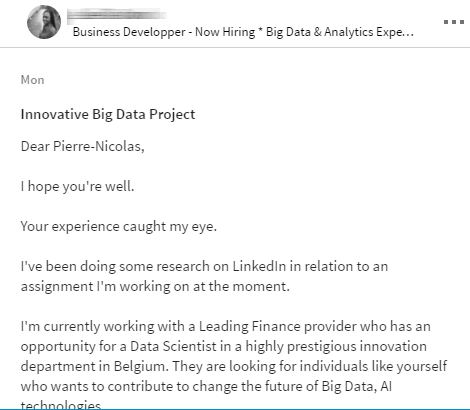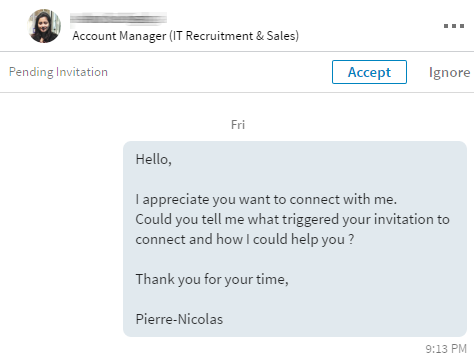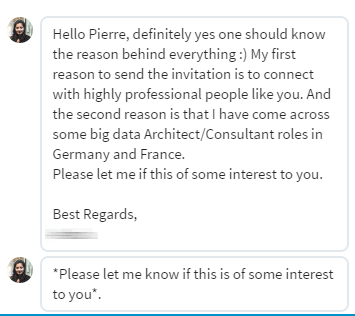There’s something I hate about Linkedin. When you are active in a sector where demand exceeds offer, you start getting all kind of bullshit InMail and connection requests from recruiters.
I’m in the Big Data consulting business; you can easily imagine what kind of attraction power my Linkedin profile represents for recruiters working on a no-cure-no-pay basis, receiving positions to fulfill from clients and not knowing where to start to find the right candidates.
For them Linkedin is like a holy grail : a worldwide database, where you can search with keywords you barely understand, coupled with marketing tools to spam as many people as possible with a bullshit message.
Let me give you a few examples of how bad recruiters work.
Example #1 : the bad use of InMail on Linkedin
Let’s start with this InMail received from a UK-based recruiter.
Interestingly I got this message 3 times under 3 slightly different forms. I guess the “recruiter” simply lost track of the too many CTRL+C / CTRL+V she had already done and sent the same message to many different “candidates”. So far on the form. Now let’s focus on the content. My guess is that the “recruiter” typed two keywords in Linkedin’s search engine : “Big Data” and “Belgium” and spammed all people the search engined returned. Because honestly, who would think that after 20 years in the business and various managerial positions I’d like to go back to a Data Scientist role ?
Lesson learned: if you send an InMail, make sure you read the profile of the person first and that your message look at least a little bit attractive to her/him. Not doing your homework will result in big frustration, leading to writing a rageous blog post on a Sunday morning and blocking you forever on Linkedin. Sorry for you Leslie.
Example #2 : the bad use of connection requests on Linkedin
No more than 24 hours after example #1 occurred, I got an un-personnalized connection request from yet another UK-based recruiter (are all recruiters UK-based or what?)
Like with all un-personnalized Linkedin connection requests I get (i.e. 99% of them) I sent back an un-personnalized piece of text to ask for more info.
This recruiter wasn’t as bad as the previous one because she replied back.
The answer is acceptable but you understand from her reply that what she really drove the connection request was the search for candidates. Same symptoms as in the previous case. Homework not done. After 20 years years in business and managerial roles, I’m really not excited about going down the ladder and being employed as a consultant.
Conclusion
Use Linkedin wisely. Linkedin is a tool that should allow you to verify that a potential candidate has the qualities to be interested by an offer. Linkedin is not a marketing database to be used for spamming people. All you’ll get by doing that is frustration from people you have tried to contact and bad word-of-mouth.
Image : Shutterstock
Posted in Marketing.


